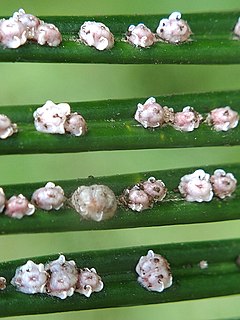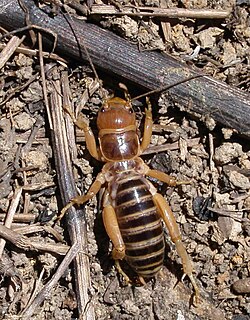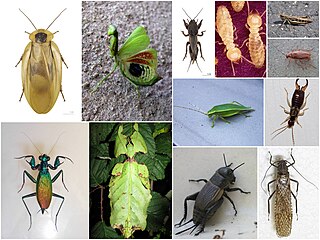
Pitcher plants are several different carnivorous plants which have modified leaves known as pitfall traps—a prey-trapping mechanism featuring a deep cavity filled with digestive liquid. The traps of what are considered to be "true" pitcher plants are formed by specialized leaves. The plants attract and drown their prey with nectar.

The Phasmatodea are an order of insects whose members are variously known as stick insects, stick-bugs, walking sticks, or bug sticks. They are generally referred to as phasmatodeans, phasmids, or ghost insects. Phasmids in the family Phylliidae are called leaf insects, leaf-bugs, walking leaves, or bug leaves. The group's name is derived from the Ancient Greek φάσμα phasma, meaning an apparition or phantom, referring to their resemblance to vegetation while in fact being animals. Their natural camouflage makes them difficult for predators to detect; still, many species have one of several secondary lines of defence in the form of startle displays, spines or toxic secretions. Stick insects from the genera Phryganistria, Ctenomorpha, and Phobaeticus includes the world's longest insects.

The rove beetles are a family (Staphylinidae) of beetles, primarily distinguished by their short elytra that typically leave more than half of their abdominal segments exposed. With roughly 63,000 species in thousands of genera, the group is currently recognized as the largest extant family of organisms. It is an ancient group, with fossilized rove beetles known from the Triassic, 200 million years ago, and possibly even earlier if the genus Leehermania proves to be a member of this family. They are an ecologically and morphologically diverse group of beetles, and commonly encountered in terrestrial ecosystems.

Thomas Say was an American entomologist, conchologist, and herpetologist. His definitive studies of insects and shells, numerous contributions to scientific journals, and scientific expeditions to Florida, Georgia, the Rocky Mountains, Mexico, and elsewhere made him an internationally known naturalist. Say has been called the father of American descriptive entomology and American conchology. He served as librarian for the Academy of Natural Sciences of Philadelphia, curator at the American Philosophical Society, and professor of natural history at the University of Pennsylvania.

Scale insects are small insects of the order Hemiptera, suborder Sternorrhyncha. Of dramatically variable appearance and extreme sexual dimorphism, they comprise the superfamily Coccoidea. Adult females typically have soft bodies and no limbs, and are concealed underneath domed scales, extruding quantities of wax for protection. Some species are hermaphroditic, with a combined ovotestis instead of separate ovaries and testes. Males, in the species where they occur, have legs and sometimes wings, and resemble small flies. Scale insects are herbivores, piercing plant tissues with their mouthparts and remaining in one place, feeding on sap. The excess fluid they imbibe is secreted as honeydew on which sooty mold tends to grow. The insects often have a mutualistic relationship with ants, which feed on the honeydew and protect them from predators. There are about 8,000 described species.

The family Gryllidae contains the subfamilies and genera which entomologists now term true crickets. They belong to the Orthopteran subfamily Ensifera, having long, whip-like antennae and has been reduced in terms of the older literature, with taxa such as the spider-crickets and allies, sword-tail crickets, wood or ground crickets and scaly crickets elevated to family level. The type genus is Gryllus and the first use of the family name "Gryllidae" was by Walker.

Ensifera is a suborder of insects that includes the various types of crickets and their allies including: true crickets, camel crickets, bush crickets or katydids, grigs, weta and Cooloola monsters. This and the suborder Caelifera make up the order Orthoptera. Ensifera is believed to be a more ancient group than Caelifera, with its origins in the Carboniferous period, the split having occurred at the end of the Permian period. Unlike the Caelifera, the Ensifera contain numerous members that are partially carnivorous, feeding on other insects, as well as plants.

Snakeflies are a group of predatory insects comprising the order Raphidioptera with two extant families: Raphidiidae and Inocelliidae, consisting of roughly 260 species. In the past, the group had a much wider distribution than it does now; snakeflies are found in temperate regions worldwide but are absent from the tropics and the southern hemisphere. They are a relict group and have been considered living fossils, as species from the early Jurassic period closely resemble modern-day species.

Conospermum is a genus of about 50 species in the family Proteaceae that are endemic to Australia. Members of the genus are known as smokebushes - from a distance, their wispy heads of blue or grey flowers resemble puffs of smoke. They have an unusual pollination method that sometimes leads to the death of visiting insects. They are found in all Australian states, though most occur only in Western Australia. Smokebushes are rarely cultivated, though the flowers of several Western Australian species are harvested for the cut flower industry.

A leaf miner is any one of numerous species of insects in which the larval stage lives in, and eats, the leaf tissue of plants. The vast majority of leaf-mining insects are moths (Lepidoptera), sawflies, and flies (Diptera), though some beetles also exhibit this behavior.

Calosoma is a genus of large ground beetles that occur primarily throughout the Northern Hemisphere, and are referred to as caterpillar hunters or caterpillar searchers. Many of the 167 species are largely or entirely black, but some have bright metallic coloration. They produce a foul-smelling spray from glands near the tip of the abdomen. They are recognizable due to their large thorax, which is almost the size of their abdomen and much wider than their head.

Anteater is a common name for the four extant mammal species of the suborder Vermilingua commonly known for eating ants and termites. The individual species have other names in English and other languages. Together with the sloths, they are within the order Pilosa. The name "anteater" is also commonly applied to the unrelated aardvark, numbat, echidnas, pangolins, and some members of the Oecobiidae.

Jerusalem crickets are a group of large, flightless insects in the genera Ammopelmatus and Stenopelmatus, together comprising the subfamily Stenopelmatinae. The former genus is native to the western United States and parts of Mexico, while the latter genus is from Central America.

Titanoptera is an extinct order of neopteran insects from late Carboniferous, Permian, and Triassic periods. Titanopterans were very large in comparison with modern insects, some having wingspans of up to 36 centimetres (14 in).

Dactylopius is a genus of insect in the superfamily Coccoidea, the scale insects. It is the only genus in the family Dactylopiidae. These insects are known commonly as cochineals, a name that also specifically refers to the best-known species, the cochineal. The cochineal is an insect of economic and historical importance as a main source of the red dye carmine. It has reportedly been used for this purpose in the Americas since the 10th century. Genus Dactylopius is also important because several species have been used as agents of biological pest control, and because several are known as invasive species.
Permutotetraviridae is a family of viruses. Lepidopteran insects serve as natural hosts. The family contains one genus that has two species. Diseases associated with this family include: infection outcome varies from unapparent to lethal.
Nemoleontini is an antlion tribe in the subfamily Myrmeleontinae.
Creoleon elegans is a species of antlions in the subfamily Myrmeleontinae. It is found in Iran.

The cohort Polyneoptera is a proposed taxonomic ranking for the Orthoptera and all other Neopteran insects believed to be more closely related to Orthoptera than to any other insect orders. These winged insects, now in the Paraneoptera, were formerly grouped as the Hemimetabola or Exopterygota on the grounds that they have no metamorphosis, the wings gradually developing externally throughout the nymphal stages.
Campocraspedon is a genus of ichneumonid wasp in the insect order Hymenoptera. It comprises six species.
















